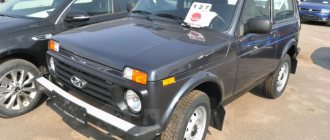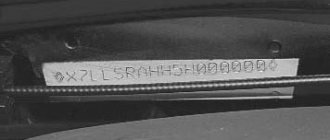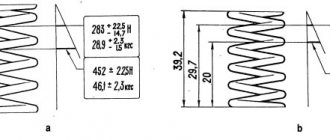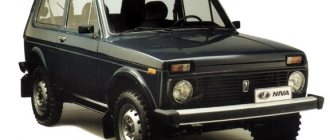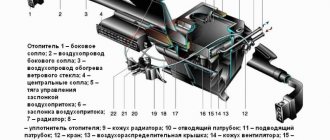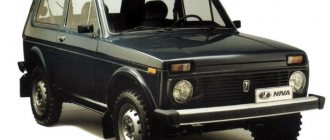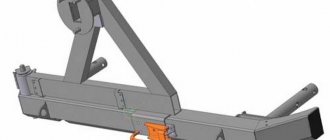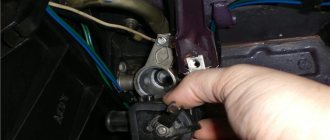Sometimes, information about where the engine number is located on the Niva is simply necessary. The knowledge will be useful when traveling to state automobile inspection authorities. If a car is sold, bought, registered or deregistered, manipulations with the engine and body are impossible in the absence of factory identifiers.
The individual mark applied to the body and power plant cannot be faked or changed. The information encoded in the marker is stored in the database of the manufacturer and government regulatory authorities. Reconciliation and matching of the applied symbols guarantees the originality of the product and prevents counterfeiting.
Chevrolet Niva:
Vin number, where it is located
Fundamentally!
The wine does not break into details; it is written on special plates, also called stickers. A unique code, which contains information about all the properties of the car, is located in several places. To make it easier to find and save information, one sticker is placed to the right of the driver, where the passenger’s legs are located. The table with the code is closed with a plastic plug.
If it is not possible to find primary information about the body data, the sticker is damaged or missing completely, then duplicate plates are placed on the body, there are two of them. Usually, they are located in the front of the car, on the left B-pillar. Thus, the driver, sitting in his seat, will always see the car’s data.
If there is no plate with a code, in other words, only half is there, then when registering a vehicle, employees of the State Traffic Inspectorate often focus such cars on additional examination, this amounts to monetary costs and loss of time.
Vin number, where it is located
Important! The wine does not break into details; it is written on special plates or stickers.
A unique code, which contains information about all the characteristics of the car, is located in several places. To make it easier to find and save information, one sticker is located to the right of the driver, where the passenger’s feet should be. The table with the code is closed with a plastic plug.
If it is not possible to find primary information about the body data, the sticker is damaged or missing altogether, then there are duplicate plates on the body, there are two of them. Typically, they are located in the front of the car, on the left B-pillar. Thus, the driver, when sitting in his seat, will always see the vehicle data.
If there is no plate with a code, or only half is present, then when registering a vehicle, such cars may be sent for additional examination by State Traffic Inspectorate employees, which means financial costs and a loss of time.
Where is the engine number on a Chevrolet Niva
Initially, the Chevrolet Niva (VAZ 2131) was designed as a second generation Niva with the factory marking VAZ 2123. Due to a lack of funding, in 2001 the model came under the jurisdiction of Chevrolet along with the name Niva. The predecessor of the new Niva had a VAZ 2121 (1.5 liters) power plant, which underwent changes and was introduced to users in the 90s as the VAZ 21213 (1.6 liters).
Finding the markings on the motor is not difficult; the model and number are marked on the frame platform, located horizontally on the left side of the unit. When searching, pay attention to the plane where the block and head open, in the area of the spark plugs of the third and fourth cylinders.
Engine number on Niva (VAZ 21214):
Information about the car is displayed on an identification plate, which is attached with rivets in the space under the hood. You can find the plate by looking at the right side of the front body panel.
Identifier plate and VIN code:
The Niva body identification number (VIN code) is stamped to the side of the plate. This identifier is in duplicate, the second is stamped on the floor in the luggage compartment; to access, remove the upholstery.
VIN code in luggage compartment:
How to decrypt information
The information encoded in the Chevrolet Niva car identifier carries meaning. Thus, the engine marker encodes the modification of the unit and the order in which it was produced at the factory.
Identifier (VIN):
The identifier “X9L21230030011096” has the following information:
- X9L - international creator identifier:
- X – European countries;
- 9 – Russia;
- L – “GM-AVTOVAZ”;
- 212300 – modification of the machine;
- 3 – code of the model year of the vehicle;
- 0011096 – serial number of the car body.
Vehicle model year code:
| Cipher | date |
| A, B, C… H | 01.07.1979-30.06.1980 … 01.07.1986-30.06.1987 |
| J, K, L… N | 01.07.1987-30.06.1988 … 01.07.1991-30.06.1992 |
| P | 01.07.1992-30.06.1993 |
| R…T | 01.07.1993-30.06.1994 … 01.07.1995-30.06.1996 |
| V, W, X…Y | 01.07.1996-30.06.1997 … 01.07.1999-30.06.2000 |
| 1, 2, 3…9 | 01.07.2000-30.06.2001 … 01.07.2008-30.06.2009 |
| A | 01.07.2009-30.06.2010 |
Some information about the car is located on the vehicle information plate.
Information plate:
The identifier contains the following information:
- Product manufacturer's name;
- Certification mark;
- Code of the identified person who issued the certificate;
- Vehicle number;
- Modification of the power plant;
- Permissible weight of the machine;
- Permissible weight of the vehicle with trailer;
- Load on the front pair of wheels;
- Load on the rear pair of wheels;
- Order no. of spare parts;
- Execution option and equipment.
Where is the body number Niva 2121
The vehicle identification number (VIN) is stamped on the right front fender mudguard.
The duplicate vehicle identification number (VIN) is stamped on the right side of the luggage compartment floor.
Vehicle data is given on a plate attached to the horizontal shelf of the front panel.
The engine number is stamped on the left side of the cylinder block (above the oil filter).
Example of car data designation:
- XTA – manufacturer code;
- 212140 – car model;
- 1 – model year of the car;
- 1580133 – body number;
- 21214 – engine model;
- 1610 kg – permissible maximum vehicle weight;
- 2210 kg – permissible weight of the vehicle with trailer;
- 1–780 kg – front axle load – 780 kg;
- 2–830 kg – rear axle load – 830 kg;
- 20 – version;
- 010 – configuration number;
- 1504738 – number for spare parts.
Reg.: 08/23/2009 Threads / Messages: 2 / 11855 From: Nizhny Novgorod region, Vyksa district Age: 35 Car: VAZ-2121 1985 VAZ-21093 1994
Reg.: 01/31/2020 Messages: 4 From: Pyatigorsk Age: 31 Car: VAZ 2121 1982
Well, I know that there are such comrades, but I just have no idea where to get them in our city, and this method will already be an option, and it’s not too bad to get in with it.. of course there is an idea to take it and write a power of attorney yourself handwritten saying that my grandfather (who died) is giving me a car, I’ll sign it, insurance is issued without problems if you have money and a registration certificate, the only issue is with the technical inspection. It’s clear that I won’t go there and will go through everything like a law-abiding citizen, everything is done for the same amount. to the place where there are holes in the vin code, put back the nonsense that was there, pour holy water on this place and drive carefully so that you don’t get the idea of checking this code with the POLICE OFFICERS) and even if I break something and they check the vin code according to the registration certificate, it’s not removed from the register and there in their traffic police it is not said that the owner died. The only thing that raises a question in my mind is that when I went through the examination, I used a special liquid to remove the paint in the area of this license plate down to the metal. And the second question is about the tax, I don’t know whether the tax on this car goes to that family or how in general
Added after 12 minutes 34 seconds:
During a conversation with a friend, the problem became clear... it concerns technical inspection. I don’t intend to go there with this car, BUT, I get insurance for it, the insurance says that the owner is a grandfather, I am the insured. to those who will do the inspection, I will need to give a registration certificate, insurance and this power of attorney, BUT with a handwritten power of attorney it will not work, you need a general, and a general is a re-registration from grandfather to grandmother, and this is a hemorrhage, again everything will come down to this number with the examination. .. there are, of course, documents about the right to inheritance and a death certificate, but it’s better not to show them to the cops... in short, we wait for the end of Holy Week and go kill the liver in communication with the cops))
Reg.: 08/23/2009 Threads / Messages: 2 / 11855 From: Nizhny Novgorod region, Vyksa district Age: 35 Car: VAZ-2121 1985 VAZ-21093 1994
Identification numbers
| 60 posts on previous pages |
Also interesting: Options and prices of LADA Niva 3-door.
Buy Niva in Moscow in the AutoHERMES showroom Structure vin
Improvement of products is a continuous process of any continuous production. At the same time, with the exception of cases of major changes in the design of models coming off the assembly line, the results of the modification process are not covered in the vehicle’s operating manual. However, the manufacturer draws up numbered lists of manufactured spare parts, which is why the information encoded in the vehicle identification numbers is of particular importance when purchasing the latter. When placing an order for the necessary spare part, try to provide the seller with as much information as possible about your car. Be sure to provide the model name, year of manufacture, as well as body and power unit numbers.
- The chassis number is stamped on the front panel of the car body.
- The engine number is stamped on the cylinder block.
- The transmission number plate is attached to the top of the transmission housing.
Don't confuse the transmission number with the engine number.
VEHICLES WITH 5 DOOR HATCHBACK
There is no chassis number on the front cross member (above the radiator).
On some modifications of the car, the chassis and engine numbers are duplicated on a plate that is attached to the front panel of the body.
On other modifications of the car, a plate with the chassis number is located on the front cross member of the body (above the radiator).
Some vehicle options include a certification plate located on the rear end of the driver's door.
VEHICLES WITH 5 DOOR HATCHBACK
There is no certification plate on the end of the driver's door.
Vehicle identification number (vin)
This extremely important number is stamped on the rear bulkhead of the engine compartment, as well as on a nameplate mounted on the instrument panel under the windshield on the driver's side of the car. The vin is also entered into the vehicle title and registration certificate. The number contains information about the date/place of manufacture and body type of the car (see accompanying illustration).
Engine code and model year
The two main components of the vin are the model year code and the assembly line/body/engine code.
Counting from left to right, the 4th, 5th and 6th positions of the number are assigned to the assembly/body/engine line code. Thus, civic models are determined by the following combinations:
ej6 = 3-door/d16y7 ej7 = 2-door/d16y5 ej8 = 4-door/d16y8
Integra models are characterized by combinations:
dВ7 = 4-door/В18В1 dВ8 = 4-door/В18С1 dС2 = 3-door/В18С1, В18С5 dС4 = 3-door/В18В1
The tenth position of the vin determines the year of manufacture of the model:
r = 1994 s = 1995 T = 1996 v = 1997 w = 1998
The engine number, which is impossible to do without when ordering spare parts for the power unit, is located on the right (on the passenger side of the car) on the block, next to the exhaust manifold. The first five positions of the number determine the engine code. This manual covers models equipped with the following four engine types:
Also interesting: How to replace a low beam lamp on a Chevrolet Niva: instructions
d16y5 = 1.6 l, sohc, 16-valve, vtec-E d16y7 = 1.6 l, sohc, 16-valve d16y7 = 1.6 l, sohc, 16-valve, vtec
В18В1 = 1.8 l, dohc, 16-valve В18С1 = 1.8 l, sohc, 16-valve, vtec В18С5 = 1.8 l, dohc, 16-valve, vtec
This number is required when ordering spare parts for transmission line repair. On models equipped with a manual transmission, the transmission number is stamped on the clutch dome, next to the starter. On models with AT, the number is located on the right front of the transmission housing, near the dipstick. On models equipped with cvt, the number is located on a vertical platform, also near the dipstick.
Other section materials
| Vehicle and Engine Identification NumbersThe vehicle identification number (VIN) is stamped on the right front fender mudguard…. |
| Technical characteristics of cars ParametersVAZ-21213VAZ-21214BodyAll-metal, load-bearing, two-volumeNumber of doors… |
| General information: VAZ-21213 and its modifications are all-terrain passenger cars. All wheels are constantly driven (non-disconnectable full... |
| Safety precautions during repairsThe room where repair work is carried out must be well ventilated, the door must be easy to open from the inside,… |
Where are the blocks and relays located in Niva 21214 and 21213
The main power supply in these models is located under the lower edge of the instrument panel protection. Additional fuses in Niva 21214 for the injector are located to the left. This block is responsible for controlling fuel injection. There are also relays for monitoring the operation of the wipers and a set responsible for the motion control system.
Another fuse box is installed in the body to the left of the main one. They are responsible for the cooling system and how the engine works. There is also a diagnostic connector. The relay that controls the starter is located either next to the main power supply, or under the hood next to the brake fluid reservoir.
Causes
From time to time, the Chevrolet Niva engine starts to troit in a car, which is an SUV, where these problems can also occur.
Fuel ignition occurs early or, conversely, late.
Fuel ignition occurs late or, conversely, ahead of time due to faulty spark plugs, they produce a weak spark, or it appears at the wrong time. A weak spark appears due to the fact that carbon deposits accumulate on the spark plug, which prevents breakdown. Another reason that it is weak is the destruction of the insulator, and in the place where it is destroyed, soot appears, which prevents the normal appearance of a spark.
Fuel does not enter the cylinder evenly.
The reason that fuel unevenly enters the cylinder may be due to a malfunction of any parts of the fuel pump, for example: a pressure valve, pressure reducing or injection valve. But if fuel is supplied, on the contrary, in excess, then the problem is most likely in the fuel injectors; they may be clogged and need to be cleaned or replaced.
There is excess or lack of air in the combustion chamber.
Excess air in the cylinders indicates that a depressurization has occurred in the air supply system. But lack of air can be caused by a dirty air filter or a broken throttle valve. The engine may not operate properly due to the failure of the sensor, which is responsible for the position of the throttle valve, as well as the sensor responsible for the operation of the mass air flow.
The need to check the engine number
Until recently, the engine number of the Niva Chevrolet and other car brands was a mandatory attribute entered into the car’s passport. According to the new rules, this information is not required. However, when a car or engine is identified, there is simply no other option. Therefore, traffic police officers maintain a database of license plates with which they compare a particular vehicle.
For this reason, every responsible user knows where to find the engine markings and where the body number is located on the Niva. In addition, the driver’s responsibilities include caring for the location of this information.
VAZ engine number
The marking on the engine is applied to a special area of the cylinder block. The labeling process is mechanized.
On engines produced before December 1974 (VAZ-2101, VAZ-2102, VAZ-2103), the marking area was located on the front upper end of the cylinder block.
Since the second half of 1975, the marking area on engines has been located on the tide of the block, to the left in the direction of travel, above the oil filter. On engines manufactured from December 1974 to July 1975, markings are found on both sites. Since July 1975, at the previous location of the engine number, only the engine technological number, consisting of three digital characters, has been applied.
Photo. General view of the number applied to the engines of VAZ-2101-VAZ-2107 cars.
Markings are applied to engines of all models, except the VAZ-2108, using an automatic German numbering machine, as well as a VAZ KVTs numbering machine. On the engines of VAZ-2108 cars, markings are applied with a numerator.
Rice. Engine numbers, made on a metal plate with a numerator: a) - ; b) — VAZ KVTs; V) - . The sizes of this font and stamp imprints are shown in the figures.
Rice. Custom non-guest font options
Rice. Sign imprints made on a metal plate
On engines of VAZ-2108 and VAZ-2109 cars and their modifications, the number is located on the upper part of the rear wall of the block on the flywheel side, to the left in the direction of travel (close to the distributor breaker).
The surface of the site is subjected to mechanical processing on a milling machine before marking is applied. On the engine blocks of VAZ-2101, VAZ-2102, VAZ-2103, VAZ-21011, VAZ-2104, VAZ-2105, VAZ-2106, VAZ-2107, VAZ-2121 and their modifications, not only the platform for markings, but also surfaces for the oil filter and fuel pump.
The location of the number on the site relative to its conventional center or boundaries is not regulated.
The serial number on engines, starting with the VAZ-2108, must be between two asterisks (dividing marks). The distance between the outer digits and asterisks on each side, as well as the distance between individual markings, should be no more than half the width of the digit.
Also interesting: Do-it-yourself trunk for the field
From 1984 to 1985, on VAZ-2108 car engines, the placement of signs in the number was carried out in two lines, then from 1986 - in one line.
Photo. General view of the number applied to the engines of VAZ-2108 cars and their modifications
Rice. Parameters and location of characters in the number designation: a - in two lines; b - in one line
The year of engine manufacture is indicated by letters of the Latin alphabet. In the number designation (in particular, on VAZ-2108 engines and its modifications), the letter indicating the year of manufacture is located immediately after the model index, and the number looks like this: “2108f* 0000001*. The letter F indicates that the engine was manufactured in 1985.
List of letters of the Latin alphabet used to indicate the year of manufacture of the engine.
Year
Designation
Year
Designation
In 1985-1986 all engines of VAZ-2108 cars and its modifications contained a letter in the number indicating the year of manufacture. Since 1987, it began to be applied in the number not to all engines, but mainly to those that entered the domestic market, since car importing countries asked not to include a letter of the Latin alphabet indicating the year of manufacture in the designation of the engine number. Abroad, the presence of a letter in the number immediately after the model was perceived as a modification of the main model. In this regard, since 1987, the plant practically ceased to indicate the year of manufacture on VAZ-2108 engines, since there was no clear distinction between products that were to be sold on the domestic market and those that would be sold abroad.
Pros and cons of the injector
Which is better - Niva carburetor or injector? Among the advantages of the carburetor Niva, it should be noted:
- Simple design of the power system. In the event of a breakdown, you can fix the problem yourself.
- Cheap service.
- Unpretentiousness to fuel quality. Many Soviet Nivas can easily “digest” even 76-octane gasoline.
- Lack of many sensors.
It would seem that the answer has been found to the question of which is better - a Niva carburetor or an injector. However, a carburetor engine has more disadvantages. Among them:
- Low reliability. Every season you need to adjust the carburetor and carry out its maintenance.
- Dependence on air temperatures. In winter, the spark plugs could easily be overfilled, making starting impossible until the spark plugs were subsequently unscrewed and dried. Also, in winter, due to condensation, the float often “stuck”. And in the summer the fuel pump often got hot.
- Greater fuel consumption.
- Less productivity. To unlock the potential of the engine, it was necessary to spin it up to high speeds.
No matter how simple and maintainable this power system may be, it requires a lot of attention. Over the course of a year of operation, you will have to rebuild the carburetor several times. A modern car enthusiast is unlikely to be happy with this situation (especially adjusting the carburetor or drying spark plugs in 20-degree frost).
Which is better - Niva carburetor or injector? This question interests many car enthusiasts. Here are the advantages of the injection Niva:
- Stable operation of the internal combustion engine. Thanks to the presence of IAC, owners have forgotten what floating speed is. For carburetor engines this was a real disease.
- Great performance. The fuel-injected Niva responds more quickly to the gas pedal.
- Less fuel consumption. We have already seen this by looking at the technical specifications. With the arrival of the injector, consumption decreased by 20 percent.
- Excellent starting in any weather. The injection engine does not flood the spark plugs, and in the summer the fuel pump does not overheat. The latter is submersible and is cooled by gasoline, as it is located in the tank.
- Reliability. Since there is no carburetor, there is no need to regularly tune it, change jets and clean it. The maximum that the owner of an injection-powered Niva can do is clean the throttle valve, but this procedure is by no means mandatory. It is recommended to do this only if the car selects high idle speeds.
What are the disadvantages of the fuel-injected Niva? There aren't many of them. Since more electronics have been added to the system, owners may experience faulty control sensors. If the car begins to consume a lot of fuel, it is worth looking at the mass air flow sensor. If the engine does not maintain normal speed at idle, the IAC may be to blame.
And if the engine refuses to start, the contact may have come loose from the crankshaft position sensor. But fortunately, these problems don't happen that often. And you can diagnose them with a simple multimeter by measuring the resistance or contact voltage of one of the sensors. Thus, breakdowns mainly concern only electronics. The mechanical part does not raise any questions.
And also interesting: What will the new Niva 2017-2018 be like?
This is interesting: How much does a Muscovite car weigh?
Diagram and location of the fuse box Niva VAZ-21213 and 21214
In this material we will introduce you to the Niva fuse box 21213 and 21214, the purpose of the fuses, and the nuances of the additional VAZ-21214 fuse box, which is responsible for the injection system and is located in a separate block on the left side under the instrument panel. Externally the block looks like this:
The fuse numbers in it are as follows:
And here’s what a separate injection system unit looks like; by the way, it contains the electric fan fuse, including:
Below are the assignments of the Niva fuse blocks, both the main one and the injection system:
No. Power A Designation of fuse
Fuse box located under the control panel
1 16 Heater fan - electric motor Headlight cleaner and headlight wiper motor in all wiper positions except the initial position Heated rear window - switch on relay (winding) Rear window cleaner and washer Windshield washer
2 8 Turn signal, relay turn signal and hazard warning switch - turn signal mode Reversing lights Windshield wiper (gear motor and relay) Generator - field winding Warning lamps: brake fluid level, oil pressure, carburetor choke, parking brake Coolant temperature gauge fluids Fuel level indicator, reserve indicator lamp Voltmeter
3 8 High beam - left headlight, control panel warning lamp
4 8 High beam - right headlight
5 8 Low beam - left headlight
6 8 Low beam - right headlight
7 8 Side lights: left front and right rear, instrument panel indicator lampLicense plate light
8 8 Side lights: right front and left rear Lighting: instrument panel, cigarette lighter, switches and interior switches
9 16 Turn signal and relay hazard warning light interrupter Hazard warning light indicator Heated rear window: heating element and switching relay (contacts)
10 16 Horn Socket Interior lighting Stop light - tail lights
12 (13) 8 Fog lights - rear Headlight cleaner - electric motor: starting moment, moment of passage of the initial position brushes
16 (15) 16 Cigarette lighter
For VAZ-21214, the injection system fuses are located in a separate block on the left side under the instrument panel.
1 30 Cooling fans
2 15 Electric fuel pump
3 15 Control unit
4 15 Main relay of the injection system
Attention, on the fields of later years of production, the connection diagram for the second, lower fuse block is slightly different. Instead of the traditionally two fuses involved, as many as four are involved. Here is a photo and diagram of the differences:
We hope that this information was useful to you if you encounter problems with the electrical equipment of NIVA. We will be glad to see you in the Niva owners club on our forum.
What has changed with the arrival of the fuel-injected Niva?
To find out which Niva is better - carburetor or injection, first you need to consider the technical characteristics of both models. So, let's start in order. Initially, the engine for the Niva was taken from the classic Zhiguli. This is the same engine, but with an increased volume of the combustion chamber. The first for a Soviet SUV was the 2121 engine with a displacement of 1580 cubic centimeters. A few years later, the car began to be equipped with a more modernized engine. The engine received the index 21213. This is a motor with a displacement of 1690 cubic centimeters. The power of the power unit is 83 horsepower. With this internal combustion engine, the car became more playful. Acceleration to hundreds decreased to 18 seconds.
In 2005, the Volzhsky Automobile Plant switched to injection engines. This change affected all VAZ models, including the Niva. So, the car began to be equipped with an engine with the index 21214. This is a gasoline unit with a volume of 1690 cubic centimeters. The engine power remained the same as the carburetor version - 83 horsepower. Acceleration hasn't changed either. But the car’s fuel consumption has decreased by one and a half liters.
Currently, Niva cars are produced with the 21214-28 engine. These are Euro 4 engines. The working volume of the internal combustion engine is 1774 cubic centimeters. Power is 92 horsepower, acceleration to hundreds takes 17 seconds, and consumption is no more than 10 liters.
At the moment, all Nivas are produced exclusively with injection engines. VAZ engines immediately began to use distributed injection, where each cylinder had its own injector. All mechanical elements have been replaced with electronic ones. An electronic control unit also appeared in the car.
In order for the injection engine to operate stably, it required the presence of sensors for air control, throttle position, and detonation. In addition, the device now has a crankshaft position sensor.
Also interesting: Fuses and relays (location and purpose of fuses and relays) Niva Chevrolet
At first glance, the system seems complicated. However, it is not. Mechanically, the engine has not become more complicated. Instead of a carburetor, injectors and a fuel rail appeared, and the throttle valve was moved separately. Only a few electronic sensors have been added, on the basis of which the electronic control unit determines the mixture and ignition timing.
